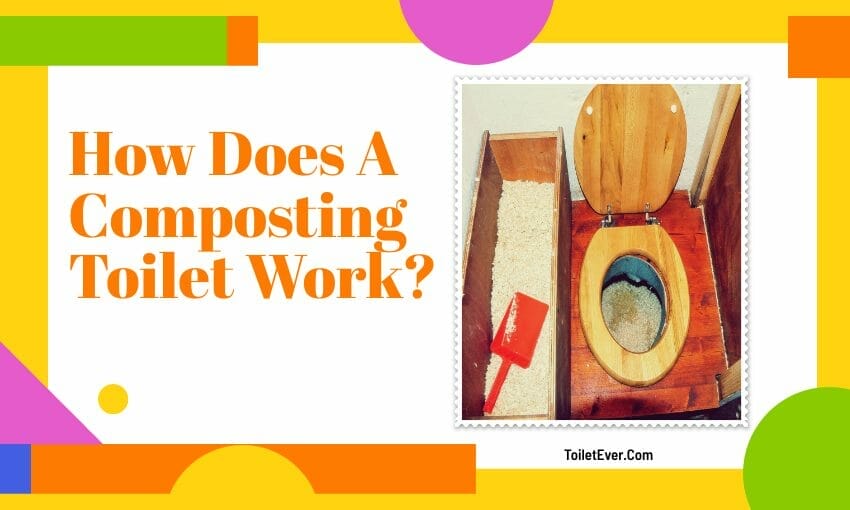
A composting toilet is a type of “dry” toilet that uses no water but instead relies on microorganisms to break down organic matter. The result is a dry substance that can be used as fertilizer or disposed of in the ground. A composting toilet could come in handy if you have limited access to fresh water, and it’s also useful for those who want a more environmentally friendly approach to sanitation. In this blog post, we’ll go over how does a composting toilet works?
What Is A Composting Toilet?
The definition of a composting toilet is a wet-dry system that separates the liquid and solid waste streams. Inside a composting toilet, solids are broken down by microorganisms so they can be converted into fertilizer or other products while liquids either evaporate or soak back into the soil as part of an irrigation process.
Compost Toilet Design
The design depends on how you want to use it. There are typically three different types: self-contained units (designed for portability), large bins with containers inside (for stationary storage), and fixed systems (located above ground). If you have limited access to freshwater then you’ll likely need something like a portable unit since they don’t require much water – just a little bit every time someone uses them. Alternatively, if your waste disposal system is already in place and you just want to supplement it, a stationary bin can be used.
The most common type of composting toilet has a large container with an aerated tank below the urine compartment (to help keep odors down). The solids go into the top section where they are mixed with dry material like sawdust or shredded paper for added moisture. This mixture goes from brown to black as bacteria break down the substances and turn them into nitrates that plants need to grow. These toilets usually have one vent pipe going outside which pulls air through vents on each side of the unit – this balances out how much fresh air enters by helping dilute any unpleasant smells coming from inside.”
Learn How Does A Composting Toilet Works
The most common type of composting toilet has a large container with an aerated tank below the urine compartment (to help keep odors down). The solids go into the top section where they are mixed with dry material like sawdust or shredded paper for added moisture. This mixture goes from brown to black as bacteria break down the substances and turn them into nitrates that plants need to grow. These toilets usually have one vent pipe going outside which pulls air through vents on each side of the unit – this balances out how much fresh air enters by helping dilute any unpleasant smells coming from inside.”
When deciding whether you want to use your compost, ask yourself these questions: Do I live in a rural area? Then you will get the answer to your question from your backyard. If you live in a city or town, how much space do I have? Perhaps there is enough room for me to garden and compost without having the odors affect my neighbors.
Here are some steps that will guide to you know how does a composting toilet works.
So, let’s start to read the rest of the article regarding this topic.
Step One
The first step in how does a composting toilet work is to place the waste into an opening at the bottom of the bowl. Some models have a special section that collects liquids, while others do not.
- Some models have a special section that collects liquids, while others do not.
Step Two
Next, you’ll need to add some dry material on top of your deposit such as sawdust or paper sheets which are usually included with most toilets, and then close off this area so it will stay separate from other parts for later use.
- This closes off this area so it stays separate until later use.
- Sawdust or paper sheets often included with most toilets.
- Must be closed off to stay separate.
Step Three
- The next step in how does a composting toilet work is the most important one, and that’s simply adding some water. The more you add here, the less often it will need to be emptied so make sure not to use too much, or else the whole process could get messy!
- Most of your deposit goes into an area below which must be closed off with sawdust or paper sheets included in many toilets for later use. – More water means a longer time between emptying out this part so don’t overdo it.
- For best results: Add enough water until only a small amount of feces remains at the bottom- but make sure not to overdo it because if there isn’t enough liquid, the compost will not stay moist enough and it won’t break down quickly.
Step Four
- The final step in how does a composting toilet work is to wait for about three months before emptying out your finished product! The reason this process takes so long is that you are allowing all of the liquid, like urine or water droplets from washing hands, to evaporate first and then come back into contact with the feces which creates an ideal situation for bacteria growth- without any oxygen present! Once there isn’t anymore leftover from your deposit, what’s created can be used as fertilizer that doesn’t smell bad when wet.
- People who have these toilets use sawdust or paper sheets inside them (which should always be included) to help control the smell.
- Keep in mind that if you have a septic system, these composting toilets are not compatible with it! This is because when human waste enters into your septic tank, there’s already an oxygen-free environment which will cause bacteria to break down the matter very quickly and produce gas as well as other foul odors. Combining humans’ poop with this type of toilet would be disastrous for your plumbing pipes or any nearby waterways close by.”
Conclusion
So, the overall comment is regarding the composting toilet work. It is a step-by-step guide on how does the composting toilet work.
It will not smell bad when wet and it can be used for fertilizer so there’s no need to worry about that either. People who have these toilets use sawdust or paper sheets inside them (which should always be included) to help control the smell. Keep in mind that if you have a septic system, these composting toilets are not compatible with it! This is because when human waste enters into your septic tank, there’s already an oxygen-free environment which will cause bacteria to break down matter very quickly and produce gas as well as other foul odors.”
So this concludes my post on How Does A Composting Toilet Work. Hope you enjoyed the article.
Do you have any other questions? Feel free to ask us.



